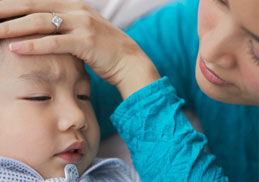Pneumonia Treatment

Pneumonia is an inflammatory condition that primarily affects the alveoli (tiny air sacs in the lungs). The air sacs or alveoli may even get filled with fluid or pus. This results in symptoms like cough with phlegm or pus, high fever, chills and breathing difficulties. People with chronic lung conditions and severe infections are most likely to experience these symptoms. Pneumonia is commonly caused due to a viral or bacterial infection.
Pneumonia is a disease in which lungs get filled up with pus like fluid mostly due to an infection.
Pneumonia can follow a common cold. The agents causing pneumonia are most often transmitted by droplet spread resulting from close contact with a source case. Contact with contaminated fomites also may be important in the acquisition of viral agents. An upper respiratory tract illness permits invasion of the lower respiratory tract by bacteria, viruses, or other pathogens that trigger the immune response and produce inflammation. The lower respiratory tract air spaces fill with white blood cells (WBC), fluid, and cellular debris. And the pathogens along with the cells, fluid and debris cause all the symptoms of pneumonia.
Commonly patients would complain of cough with green or yellow sputum; occasionally the sputum is rust colored or with frank blood, fever usually high grade (more than 100 F), chest pain while breathing -pricking or dull aching type with or without shortness of breath.
Chills (called rigors) and a change in mental status (confusion, unclear thinking) can occur.
In children, there may additionally be lethargy, restlessness, inability to eat due or loss of appetite, or abdominal pain.
Most patients are treated withoral antibioticsat home. Some severe cases might requirehospitalization,if very severe. The number of days spent in the hospital is variable, and depends upon how a person responds to treatment and if there are underlying medical problems.
Some patients, including people with previous lung damage or disease, a weakened immune system, or infection in more than one lobe of the lungs, may be slow to recover and require a longer hospitalization. Improvement occurs after three to five days of antibiotic treatment. Cough and fever decrease but fatigue and a persistent but milder cough can last for up to one month, although most people are able to resume their usual activities within seven days. Patients treated in the hospital may require three weeks or more to resume normal activities.